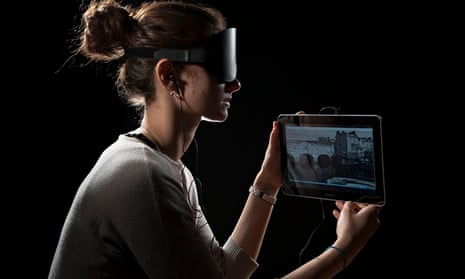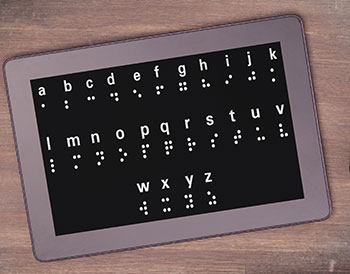Voice-Activated Assistive Devices: Simplifying Daily Tasks
Wiki Article
Empowering Independence With Assistive Modern Technology for the Blind
The integration of assistive technology into the lives of people with visual impairments stands for a considerable advancement in advertising self-reliance and self-sufficiency. From ingenious screen viewers to innovative wise canes, these devices not only improve day-to-day navigating and interaction but additionally encourage users to involve meaningfully in numerous facets of life. As we discover the myriad advantages and real-world applications of these innovations, it becomes essential to take a look at the hidden elements that contribute to their effectiveness and the possibility for future growths in this important area.Overview of Assistive Technology

The advancement of assistive innovation is grounded in principles of inclusivity and empowerment. Advancements in software, hardware, and sensory improvements offer customers with choices tailored to their specific needs. From screen readers that transform text to speech, to responsive tools that share information through touch, these devices change the method people involve with their environments.
In enhancement to functional applications, assistive technology promotes greater social inclusion and participation in different sectors, consisting of education and employment (Speech-to-text devices for low vision). As research study and development continue to develop, the possibility for assistive technology to additionally boost the lives of aesthetically impaired individuals continues to be promising, leading the way for an extra equitable culture where everyone can prosper
Kinds Of Assistive Gadgets
A variety of assistive tools have arised to support people with visual impairments, each created to satisfy specific requirements and enhance daily functioning. These gadgets range from low-tech options to state-of-the-art innovations, supplying varied options for users.Low-tech gadgets include magnifiers and large-print products that aid in analysis and writing. Braille devices, such as Braille styluses and slates, allow responsive analysis and communication. Orientation and flexibility aids, like white walking sticks, help customers browse their setting safely.
On the greater end of the range, electronic magnification systems and display readers use significant assistance. Digital magnifiers permit users to enlarge text and images on screens, while display visitors convert digital material right into manufactured speech, facilitating accessibility to details on mobile phones and computers.
Smartphone applications also play a vital function, offering functions like text acknowledgment and navigation assistance. Wearable innovation, such as smart glasses outfitted with increased reality, is arising as an appealing tool to improve situational recognition.
Advantages of Assistive Modern Technology
The assimilation of assistive technology dramatically enhances the lifestyle for individuals with aesthetic impairments. These innovations empower customers by promoting independence, allowing them to navigate their atmospheres better and execute daily tasks with greater convenience. For example, screen readers and magnifying software program allow people to gain access to electronic info, cultivating professional and academic opportunities that might have formerly run out reach.In addition, assistive gadgets such as clever walking canes and general practitioners applications provide real-time navigating assistance, improving mobility and safety. This raised freedom not just enhances self-confidence but additionally encourages social engagement, enabling individuals to take part more totally in their neighborhoods.
Assistive innovation also facilitates communication, helping individuals get in touch with others with voice acknowledgment and text-to-speech applications. This capacity is important for maintaining connections and accessing vital information.
Furthermore, the customization options available with several assistive innovations ensure that customers can customize tools to their particular requirements, even more enhancing use and performance. On the whole, the benefits of assistive modern technology for individuals with aesthetic disabilities are profound, advertising a much more inclusive culture where everybody can seek their desires and objectives.
Study and Success Stories
Highlighting the transformative influence of assistive technology, various study highlight exactly how individuals with visual problems have actually efficiently incorporated these devices right into their day-to-day lives. One compelling instance entails an university student who used display reading software application to navigate scholastic products and on the internet sources effectively. This innovation not just facilitated her education yet likewise improved her Screen readers for the blind confidence in joining conversations and group jobs.An additional instance research study features an expert who uses a smartphone application developed for navigating and item acknowledgment. By utilizing this app, he has actually regained freedom in both his individual and work atmospheres, permitting him to commute separately and involve with colleagues a lot more efficiently.
Additionally, a retired person shared her experience with braille e-readers, which enabled her to access a vast array of literature and remain gotten in touch with her community through book clubs.
These success stories emphasize the crucial function of assistive modern technology in cultivating freedom, boosting quality of life, and promoting social assimilation for people with visual impairments (Smart glasses for the visually impaired). By accepting these ingenious devices, customers can get over obstacles and seize possibilities that add to their individual and expert satisfaction

Future Trends in Assistive Innovation
Advancement in assistive technology is positioned to redefine the landscape of assistance for people with visual problems. Arising fads emphasize the integration of man-made intelligence (AI) and device learning, which improve the functionality of tools that help with navigation and info access. AI-driven applications are currently qualified of translating aesthetic information in real-time, making it possible for individuals to involve with their setting much more separately.Additionally, the growth of wearable innovation is advancing quickly. Smart glasses outfitted with augmented fact (AR) can provide audio summaries of surroundings, transforming just how customers engage with public rooms. These devices not just advertise freedom but likewise foster social addition.
In Addition, the Web of Things (IoT) is making homes smarter, enabling for seamless connectivity between day-to-day devices and assistive gadgets. This connectivity encourages users by making it possible for automated responses and voice-activated controls tailored to private needs.
Verdict
To conclude, assistive technology plays an essential role in empowering people with aesthetic impairments by boosting their freedom and interaction with their surroundings. The varied series of tools and applications available not only assists in navigation and interaction but also promotes social assimilation and opportunities for individual and expert growth. As developments continue in this area, the possibility for boosting the high quality of life for those with aesthetic problems will certainly broaden, promoting higher autonomy and empowerment.
Report this wiki page